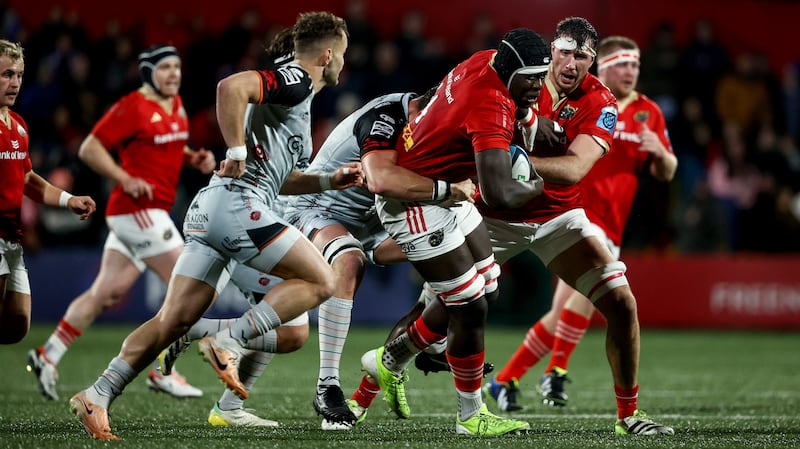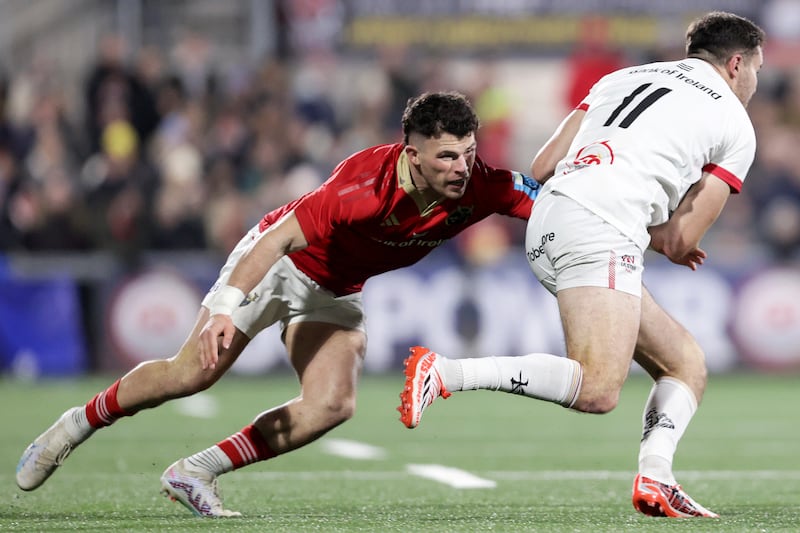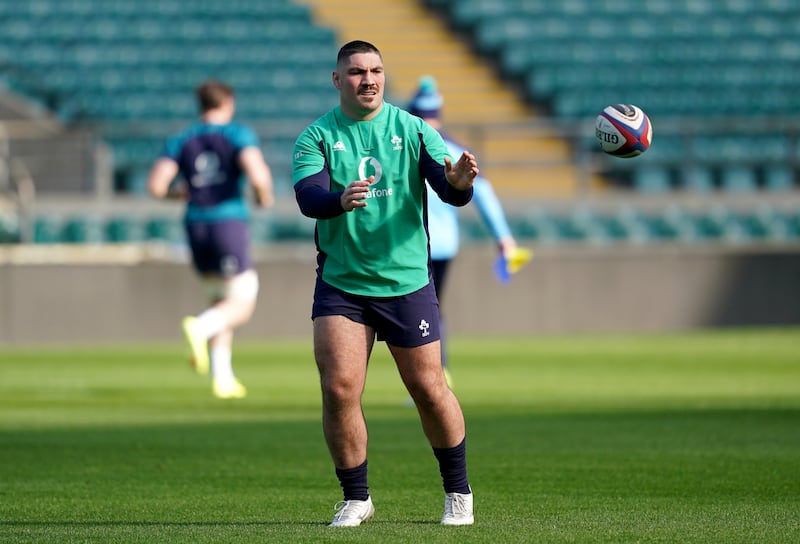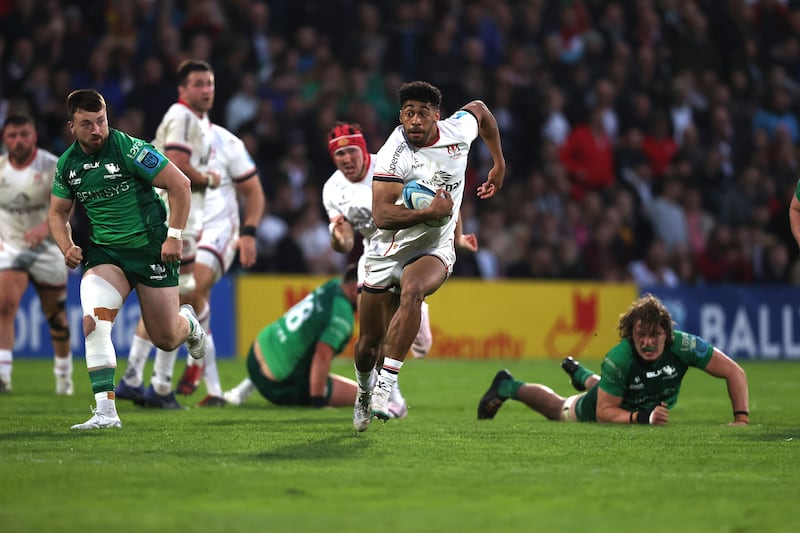Diversify the attack
There is a sense that England and Scotland somewhat stifled Ireland’s attack. Two games aren’t enough to say Ireland have been figured out, but it’s equally fair to wonder how Ireland can adapt to stay ahead of opposition defences.
In this year’s Six Nations, Ireland attacked wide more than anyone else. They moved the ball more than 10 metres from the ruck 45.1 per cent of the time, passed wider than the first receiver on 26.2 per cent of their phases and wider than the third receiver 7.4 per cent of the time - all tournament highs.
At times, the wide attack can be devastating. However, after victories against both Wales and Scotland, Andy Farrell suggested Ireland hadn’t earned the right to go wide before doing so, leading to periods of listless side-to-side play.
Against Scotland, Ireland “weren’t as direct as what we should have been in the first half”, said Farrell. After beating Wales, he explained his attackers weren’t “punching on to the ball”, saying it was “easy” to read runners out the back, which made the Irish attack too “sideways” and “passive”.
Andrew Goodman will offer his own interpretation on Ireland’s attack play when he joins the coaching staff. An easy starting point is to demand a more regular and effective close-carrying game that augments their wide threat.
Another area of note would be Ireland’s attacking efficiency and the source of their tries. According to analyst Simon Chi, in their first three games, Ireland scored 2.91 points per attack which began at a lineout in the opposition half. Against England and Scotland, this plummeted to 0.7 points. Similarly off scrums beyond halfway, Ireland averaged 1.2 points per attack in the first three rounds, that number falling to nothing thereafter.
Once teams took away the scoring viability of those platforms, Ireland’s attacking efficiency as a whole dropped. Last year, Ireland’s attack looked more varied in terms of where scores came from. The set move off a kick return for Hugo Keenan’s try against France will live long in the memory. The stats back up the eye test, Ireland scoring 2.4 points per kick return starting in the opponent’s half last year, compared to 0.4 points per return in 2024.
This year, Ireland tilted to relying more on set piece as opposed to kick return or transitions off turnover. It will be intriguing to see whether Goodman looks to diversify the source of Ireland’s attacking prowess.
Pack more punch
Finding more of that “punch” that Farrell desires could well be a key part of preparation for South Africa. In this year’s championship, Ireland were third of six countries for dominant carry rate (26.2 per cent of carries) but second for gainline success (50.9 per cent).
Ranking highly for crossing the gainline sounds strong, but players can cross the gainline without being touched by a defender. That stat coupled with Ireland ranking lower for dominant carries, ones that do go through contact, suggest Ireland are better at manipulating opportunities to run with the ball in space than powering through tacklers.
Ireland topped the tournament for post-contact metres (328m per match) but their figures against Scotland (283m) and England (182m), the final two games, were their lowest of the tournament. They trended downwards as the tournament progressed.
Part of the solution could simply be rotating important ball carriers in and out of the side a touch more often, to mitigate against fatigue. Someone such as Ryan Baird might have started more than the one match he did. With speculation surrounding Peter O’Mahony’s future, Baird’s workload could increase.

Outside of the squad, Edwin Edogbo (56 per cent), Jamie Osborne (69 per cent) and Cathal Forde (63 per cent) all have good dominant carry rates at domestic level, playing for the most part in positions where they frequently carry through heavy traffic, meaning those numbers aren’t inflated by carries in the wide channels where space is easier to find.
However, Ireland’s depth is excellent at those positions: secondrow and centre. Edogbo is also injured and likely to miss the rest of this season.
Further down the pecking order, young Leinster backrow James Culhane has impressed with a dominant carry rate of 59 per cent. In this year’s U20 Six Nations, the top four players for metres made in contact were all Irish: Hugh Gavin (161m), Bryn Ward (99m) Hugo McLaughlin (96m) and Evan O’Connell (91m).
In both the medium and long-term future, if Farrell is interested in developing younger players who have shown glimpses of a punchy carrying game, he does have options.
Become more dominant in defence
Does that requirement for more punch in the collisions come in defence as well?
In this year’s Six Nations, Ireland were second bottom for tackles that were classed as dominant (4.7 per cent). Only Wales ranked below them (4.4 per cent).
In terms of individual players, Calvin Nash, Jordan Larmour and Keenan all ranked in the top 10 for rate of dominant tackles (tackles in which a player makes contact and drives the opponent backwards). However, given they all made fewer than 20 tackles all tournament, the sample size is too small to make any sweeping conclusions.

At domestic level, though, Nash does rank highly for his dominant tackle percentage (26th among European players). His Munster teammate, Sean O’Brien, is actually ranked above him; Munster certainly use their wings well to fly out of the line and make dominant hits.
Closer in towards the breakdown, though, Irish players aren’t regularly dominant in defence. Tadhg Furlong (11 per cent) and Joe McCarthy (10 per cent) are the best among the forwards but don’t feature in the top 20 of the Six Nations’ most dominant tacklers.
Caelan Doris made the most tackles of any Irish player (66), but less than five per cent of those were dominant.
Ireland either need to find more dominant defenders, no mean feat, or compensate by slowing the ball down at the breakdown as opposed to in the collision.
Find loosehead depth
Farrell and co have built trust in more squad players than in previous years, but there are still positions where Ireland are short of international-grade talent.
Twice in this Six Nations, Andrew Porter stayed on the pitch for longer than 70 minutes. On two other occasions he lasted longer than 60 minutes. Only once was he subbed off before the hour mark. This is no slight on Cian Healy, still a strong scrummager, but there is no question that such a workload for Porter is not sustainable.
Within the Ireland squad, Tom O’Toole could move across from tighthead. He has at times displayed the carrying and defensive dynamism required, while any scrummaging deficiencies are less likely to be exposed on that side of the scrum. A move would make sense for O’Toole’s international prospects, given he appears to have fallen behind Finlay Bealham and Oli Jager in the tighthead pecking order.

However, with Ulster having a well-paid South African World Cup-winner, Steven Kitshoff, as their starting loosehead, this isn’t in the province’s interest.
Outside of the current squad, Leinster’s Jack Boyle is one loosehead who has demonstrated the required physicality, albeit against URC, as opposed to Champions Cup, opposition. The 22-year-old has been dominant on 48 per cent of his carries and draws in 2+ tacklers 83 per cent of the time, meaning he regularly opens up space for others. The latter figure is fifth highest of all players in top-flight European rugby.
Address the need for speed
Wing may appear to be a position of strength for Ireland, given the form of James Lowe, but it is undeniable that Ireland need to find more high-end options behind him and Mack Hansen. Nash acquitted himself more than capably during his first Six Nations while, when fit, Hansen and Jimmy O’Brien are the types of distributors Farrell and Mike Catt desire in their attacking system.
What Ireland lack, though, is speed. There aren’t many wings in this country with true, top-end pace. Sprint speed figures for Irish players aren’t publicly available, but what you can look at is tackle evasion percentage.
As opposed to just dominating a collision, evasion means leaving a tackler in your wake. Speed is not the only way of doing this, but looking at the most evasive players, plenty are back-three runners with a deadly combination of pace and footwork. Damian Penaud is comfortably the most evasive player in the Six Nations. Kyle Rowe, Thomas Ramos, Rio Dyer and Immanuel Feyi-Waboso also feature highly.
Ireland’s most evasive player is Keenan, who dodged 42 per cent of tackles he faced. After that, Baird, Jamison Gibson-Park, Lowe and Nash all fall more towards the middle of the pack.

Rob Baloucoune is probably the closest thing Ireland have in their system to a true speedster. Since starting against South Africa in November 2022, his form has dipped alongside that of his province, Ulster, while he has also encountered injury trouble.
Ireland’s ability to go wide is partly down to their ball-playing wings, yet their threat once in those channels could be augmented by faster, more evasive runners. A winger with both - top-end pace and distribution skills - is like gold dust. Cheslin Kolbe is one of the only such players in the world.
Regardless, it is worth considering what profile wing Ireland want to develop to complement the power, kicking game and handling ability of someone such as Lowe.











